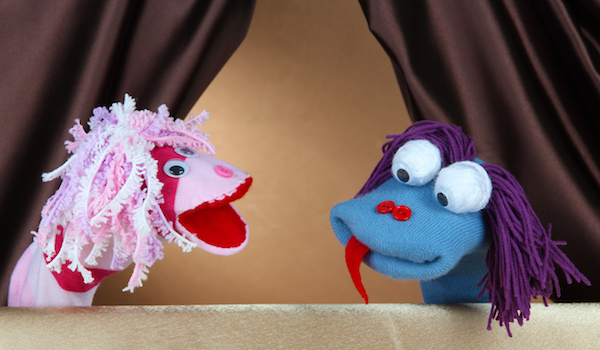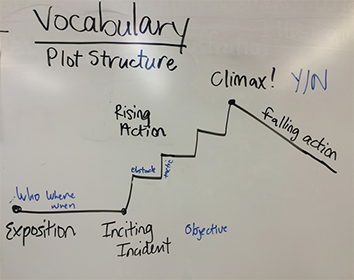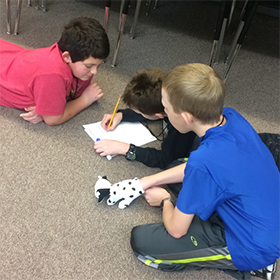SUBJECTS
GRADE
Show Results
Mother Goose Academy

Lesson Summary
- Flesh out, or complete, a nursery rhyme plot by adding a beginning and an ending.
- Act out the nursery rhyme story with a puppet.
Lesson Plan and Procedure
Lesson Key Facts
- Grade(s): 4, 5, 6
- Subject(s): Drama, English Language Arts
- Duration of lesson: 50 minutes
- Author(s): Haley Flanders Anderson
Note: Make sure you have your materials and enough room for the students to move. It is helpful if the students are already familiar with the six questions of storytelling: who, what, when, where, why, and how.
Warm-Up/Hook
Teacher: Everyone, please stand up and make a circle, facing inward. We are going to play a game called “Zip, Zap, Zop.” Those are the words you will say during the game. I will start off the game by clapping in the direction of a person in the circle and say, “Zip!” The person I clapped at does the same thing by clapping at someone else and saying, “Zap!” Then that person claps at someone else and says, “Zop!” The game continues with one person at a time saying, “Zip,” “Zap,” or “Zop.” If you say the wrong word or get off the rhythm, you are “out” and must step out of the circle.
The person who said “Zip,” “Zap,” or “Zop” right before the one who is “out” gets to start the next round. Encourage the students to try faster tempos as they get better at the game. Play until the group is in sync, focused, and energized.
Reflection
Teacher: What did you like about the game? What made it easy? What made it hard? How does this game help us? The game helps us to pay attention to what came before, so that we know what to add next. It helps us to be attentive and focused. Also, since “Zip,” “Zap,” and “Zop” are three parts to a whole, it also reminds us that every complete story has three parts as well: a beginning, a middle, and an ending. For today’s activity, we are going to take nursery rhymes and turn them into more detailed stories by adding a beginning and an ending to them. You are part of Mother Goose Academy, and your assignment is to write an original story for your rhyme by adding or creating what came before and what came after. You are writing a complete story using a nursery rhyme as the plot.
Introduction
Ask students to name different nursery rhymes. If they need help, pass out books or papers with nursery rhymes on them for the students to browse. Be aware that some cultures are not familiar with these nursery rhymes and some students may need to be introduced to them. If you choose to write one on the board, write the rhyme “Little Boy Blue” on the board:
Little Boy Blue, come blow your horn.
The sheep's in the meadow, the cow's in the corn.
Where is the boy that looks after the sheep?
He's under the haystack, fast asleep.
Will you wake him?
No, not I! For if I do, he’s sure to cry.
Teacher: How do nursery rhymes differ from fairy tales? Fairy tales are examples of strong plot structures with a good beginning, middle, and ending. However, nursery rhymes are really only part of a story. They leave a lot of unanswered questions, such as who, what, when, where, why, and how. To answer these, we need more story, and that story needs a solid structure.
Give a brief lesson on the Freytag story arc. Draw or use a chart that shows the following points on the arc:
- Exposition: The introduction to who (characters), when, and where (setting)
- Inciting Incident: The moment the character has an objective (goal)
- Rising Action: All the obstacles and events that take place to help achieve the character’s objective
- Climax: The highest point of tension, in which we are waiting to see if the objective is achieved
- Falling Action: All the events that take place after the objective has (or has not) been achieved, wrapping up the story

Instruction/Rehearsal
Teacher: Keep this structure in mind as you add a beginning and an ending to your group’s nursery rhyme. You will be in groups of four or five, and together you will write at least two to four sentences of introduction and two to four sentences of conclusion. They do not need to rhyme. You will write the rhyme in the middle of the story. When your group performs for the class, the narrator(s) will read all three parts.
Teacher: To help you come up with ideas, I will also be giving you a puppet of an animal that must be incorporated into your script and scene. Here is an example. I will use “Little Boy Blue” and a bird puppet.
Read the “Little Boy Blue” sample story. Or print it out with the worksheet if you want the groups to read it on their own and you want refer to it while they write and rehearse.
Teacher: Little Boy Blue receives a horn for his birthday. He is so excited, he plays it all day inside the house and doesn’t even sleep! The next day, his mother says he needs to play it outside from now on, but only after he does his chore: vacuuming the entire house! He asks for a different chore: using his horn to call the animals when it is time for their feeding. She agrees. She sends him to buy more food for the animals. When he comes back, it is not quite time for the animals to eat, so he takes a nap on a haystack. The animals get really hungry and start to eat all the family’s crops! His mother  and father run outside to stop the commotion and find their son.
and father run outside to stop the commotion and find their son.
Little Boy Blue, come blow your horn.
The sheep's in the meadow, the cow's in the corn.
Where is the boy that looks after the sheep?
He's under the haystack, fast asleep.
Will you wake him?
No, not I! For if I do, he’s sure to cry.
A nearby bird sees that Little Boy Blue’s mother and father are afraid to wake him, so it swoops down and squawks and flaps its wings until he wakes up and starts to cry. Little Boy Blue’s mother comforts him and takes him inside while his father shoos the bird away. Little Boy Blue calms down, feeds the animals, and goes to bed. That’s what happens when you stay up all night!
Put the students into groups of four or five, and give each group a nursery rhyme, a worksheet, and a puppet. If you do not have puppets, you can use stuffed animals instead. Give the students time to write and rehearse their scenes.
 Teacher: As you write and rehearse, focus on descriptive words that answer the six questions of storytelling. Refer to the steps in the story arc to create a solid structure to your story. Provide details in an orderly sequence. Focus on dialogue and words that engage our senses. Then consider how to animate your voice and body to create your character. Even the narrator is a performer. Be creative and have fun!
Teacher: As you write and rehearse, focus on descriptive words that answer the six questions of storytelling. Refer to the steps in the story arc to create a solid structure to your story. Provide details in an orderly sequence. Focus on dialogue and words that engage our senses. Then consider how to animate your voice and body to create your character. Even the narrator is a performer. Be creative and have fun!
Activity/Performance
Teacher: Mother Goose Academy, now it is time to present your research. Tell us the origin stories of these familiar nursery rhymes!
Have the groups perform their completed stories. It is best to number the groups before they present, so the performances run smoothly.

Conclusion
Teacher: Students of Mother Goose Academy, what story did you like the best, besides your own? How did adding a beginning and an ending enhance the nursery rhyme? How did you use the elements of the story arc? Give examples of how these stories answered the questions of who, what, when, where, why, or how.
Learning Objectives
- Establish a situation and characters who respond to actions.
- Use descriptions and concrete words.
- Provide a conclusion.
- Develop imagination.
- Write a script that focuses on the five Ws.
- Define roles and work in a group.
- Communicate character and story through physicality.
- Demonstrate audience skills.
Utah State Board of Education Standards
This lesson can be used to meet standards in many grades and subject areas. We will highlight one grade’s standards to give an example of application.
Grade 4 English Language Arts
Standard 4.W.3: Write narrative pieces to develop real or imagined experiences or events using effective technique, descriptive details, clear event sequences, and provide a resolution.
- Orient the reader by establishing a situation and introducing a narrator and/or characters; organize an event sequence that unfolds naturally.
- Use dialogue and description to develop experiences and events or show the responses of characters to situations.
- Use a variety of transitional words and phrases to manage the sequence of events.
- Use concrete words, phrases, complex sentences, and sensory details to convey experiences and events precisely.
- Use appropriate conventions when writing including text cohesion, sentence structure, and phrasing.
Grade 4 Drama
Standard 4.T.CR.1: Develop imagination to create artistic ideas and work.
Standard 4.T.CR.3: Write or record simple dramas that include the five Ws of who, what, where, when and why.
Standard 4.T.CR.4: Define roles, identify responsibilities, and participate in group decision making.
Standard 4.T.CR.5: Create character through imagination, physical movement, gesture, sound and/or speech and facial expression.
Standard 4.T.CR.7: Recognize that participating in the rehearsal process is necessary to refine and revise.
Standard 4.T.P.3: Observe, listen, and respond in character to other actors throughout a scripted or improvised scene.
Standard 4.T.P.4: Communicate meaning using the body through space, shape, energy and gesture.
Standard 4.T.R.1: Demonstrate audience skills of observing attentively and responding appropriately.
Equipment and Materials Needed
- Pencils
- Dry-erase marker and whiteboard (optional)
- Animal puppets or stuffed animals (one per group)
- Nursery rhymes (one per group)
- “Mother Goose Nursery Rhyme Origins” worksheet, which includes the “Little Boy Blue” sample story
Additional Resources
- Nursery rhymes that work well with this activity:
- “Peter Peter Pumpkin Eater”
- “Mary Had a Little Lamb”
- “Jack and Jill”
- “Little Miss Muffet”
- “Pussy Cat Pussy Cat”
- “Little Jack Horner”
- “Jack Be Nimble”
- “Humpty Dumpty”
- Links to nursery rhymes:
- Puppets/stuffed animals that work well with this activity include the following: dog, cat, giraffe, pig, bear, cow, donkey, monkey, zebra, tiger, lion, and owl.
- Demonstration of how to play “Zip, Zap, Zop”:
Image References
- Images 1–5: Haley Flanders Anderson.
- “Zip Zap Zop” warm-up game: https://dbp.theatredance.utexas.edu/teaching-strategies/zip-zap-zop

www.education.byu.edu/arts/lessons
 Download
Download